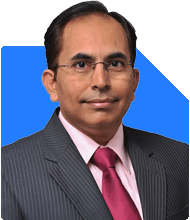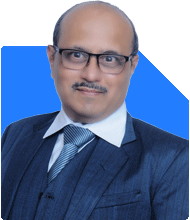Should a 40-year-old with a corpus of ₹12.25 crores aim for early retirement in 10 years?
Janak Patel |71 Answers |Ask -Follow
MF, PF Expert - Answered on Jan 29, 2025
He is the CEO and founder of InfiniumWealth, a firm that specialises in designing goal-specific financial plans tailored to help clients achieve their life goals.
Janak holds an MBA degree in finance from the Welingkar Institute of Management Development and Research, Mumbai, and has over 15 years of experience in the field of personal finance. ... more

My age is 40 and i want to retire in nxt 10 years my corpus in mf = 5 crores - ppf = 1 crore - term insurance 3.75 crore - lic = 2 crore - mediclaim = 50 lakh - owned house - land = 50 lakjs - other recurring income monthly = 16 lakhs a month
There are many things to consider for an early retirement (around age 50 as you mentioned), first is to start thinking about it in a more realistic manner. An early retirement has different meaning to each individual - opportunities to relax and pursue your passion and interests and live life on your own terms. So do think about how to keep yourself occupied once you retire.
At 50 years of age, it a still a long life ahead. Considering the investments and assets mentioned in your query, it may seem more than adequate, but some critical information are missing in it for a full assessment. What are your expenses, liabilities and plans/goals in life and also who are your dependents and what are your financial responsibilities. These need to be considered before concluding if you are well placed for the long retirement ahead.
There are many aspects that will need planning and expert guidance -
• Expense management - Regular income to cover your monthly expenses and ad-hoc/annual expenses
• Investment management - Optimize investment portfolio and plan on reinvesting maturing benefits of LIC that are aligned to your requirements
• Tax optimization of investments and reimbursements - Tax is applicable on gains from most sources of income except a few and in your case LIC (depending on the policy type) and PPF balance are tax exempt
• Risk management - besides health insurance (increase it to 1 Cr), do you need any other type of insurance, that needs to be assessed/calculated
• Succession and inheritance planning - passing of your assets and investments to family, friends or anyone you wish
I recommend you to connect with a good advisor / Certified Financial Planner who will study all aspects of your life and provide guidance and feedback and help you plan the retirement.
Thanks & Regards
Janak Patel
Certified Financial Planner.
Ramalingam Kalirajan |10874 Answers |Ask -Follow
Mutual Funds, Financial Planning Expert - Answered on Feb 04, 2025
He has an MBA in finance from the University of Madras and is a certified financial planner.
He is the director and chief financial planner at Holistic Investment, a Chennai-based firm that offers financial planning and wealth management advice.... more

My age is 40 and i want to retire in nxt 10 years my corpus in mf = 5 crores - ppf = 1 crore - term insurance 3.75 crore - lic = 2 crore - mediclaim = 50 lakh - owned house - land = 50 lakjs - other recurring income monthly = 16 lakhs a month
Understanding Your Current Financial Position
Mutual funds corpus: Rs 5 crores
PPF balance: Rs 1 crore
Term insurance cover: Rs 3.75 crores
LIC policy: Rs 2 crores
Mediclaim: Rs 50 lakhs
Owned house: No housing cost after retirement
Land: Rs 50 lakhs, but not a liquid asset
Recurring monthly income: Rs 16 lakhs
Evaluating Your Retirement Readiness
Your assets are strong and well-diversified.
Your medical and life insurance coverage is adequate.
Recurring income of Rs 16 lakhs monthly provides high financial security.
A structured withdrawal plan is needed for your corpus.
Strengthening Your Retirement Plan
Mutual funds should be balanced with equity and debt.
PPF maturity should be used for safe returns.
LIC policies should be reviewed for efficiency.
Recurring income should be managed wisely to ensure sustainability.
Investment Strategy for the Next 10 Years
Continue investing in mutual funds for long-term growth.
Increase debt exposure closer to retirement for stability.
Keep emergency funds for at least 2 years of expenses.
Avoid real estate as it locks funds and reduces liquidity.
Managing Expenses After Retirement
Define annual expense needs post-retirement.
Plan systematic withdrawals from investments.
Keep a portion of funds in low-risk instruments for liquidity.
Review your plan regularly with a Certified Financial Planner.
Final Insights
Your financial position is strong for early retirement.
Focus on asset allocation and risk management.
Keep reviewing and adjusting your plan as needed.
Best Regards,
K. Ramalingam, MBA, CFP,
Chief Financial Planner,
www.holisticinvestment.in
https://www.youtube.com/@HolisticInvestment
You may like to see similar questions and answers below
Ramalingam Kalirajan |10874 Answers |Ask -Follow
Mutual Funds, Financial Planning Expert - Answered on Jul 10, 2024
Ramalingam Kalirajan |10874 Answers |Ask -Follow
Mutual Funds, Financial Planning Expert - Answered on Jan 28, 2025
Ramalingam Kalirajan |10874 Answers |Ask -Follow
Mutual Funds, Financial Planning Expert - Answered on Feb 04, 2025
Ramalingam Kalirajan |10874 Answers |Ask -Follow
Mutual Funds, Financial Planning Expert - Answered on Jun 21, 2025
Nitin Narkhede | Answer |Ask -Follow
MF, PF Expert - Answered on Sep 03, 2025
Radheshyam Zanwar |6739 Answers |Ask -Follow
MHT-CET, IIT-JEE, NEET-UG Expert - Answered on Dec 09, 2025
Radheshyam Zanwar |6739 Answers |Ask -Follow
MHT-CET, IIT-JEE, NEET-UG Expert - Answered on Dec 09, 2025
Nayagam P P |10853 Answers |Ask -Follow
Career Counsellor - Answered on Dec 09, 2025
Mayank Chandel |2569 Answers |Ask -Follow
IIT-JEE, NEET-UG, SAT, CLAT, CA, CS Exam Expert - Answered on Dec 08, 2025
Mayank Chandel |2569 Answers |Ask -Follow
IIT-JEE, NEET-UG, SAT, CLAT, CA, CS Exam Expert - Answered on Dec 08, 2025

Mayank Chandel |2569 Answers |Ask -Follow
IIT-JEE, NEET-UG, SAT, CLAT, CA, CS Exam Expert - Answered on Dec 08, 2025
Mayank Chandel |2569 Answers |Ask -Follow
IIT-JEE, NEET-UG, SAT, CLAT, CA, CS Exam Expert - Answered on Dec 08, 2025
Mayank Chandel |2569 Answers |Ask -Follow
IIT-JEE, NEET-UG, SAT, CLAT, CA, CS Exam Expert - Answered on Dec 08, 2025
Anu Krishna |1746 Answers |Ask -Follow
Relationships Expert, Mind Coach - Answered on Dec 08, 2025
Ramalingam Kalirajan |10874 Answers |Ask -Follow
Mutual Funds, Financial Planning Expert - Answered on Dec 08, 2025
























